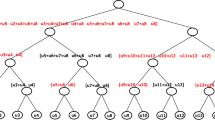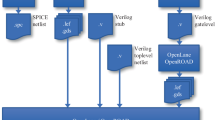Abstract
This paper proposes two variants which aim at reducing the memory requirements of the self-corrected min-sum (SCMS) with respect to min-sum (MS). The first improvement—SCMS-V1—eliminates the need for check node messages’ signs storage. The second improvement—SCMS-V2—is based on a novel imprecise self-correction rule, which allows the reduction of the erasure bits. We analyze the decoding performance and the hardware cost for the Min-Sum and three variants of the SCMS decoder for two types of regular and irregular LDPC codes, four coding rates, and two message quantizations. The decoding performance analysis indicates that the SCMS-V2 introduces almost no degradation in the error correction capability with respect to the conventional SCMS, while it has an almost 0.5 dB better performance compared to MS. Regarding the implementation analysis, we use an LDPC customizer tool developed by us in order to generate FPGA based LDPC layered architectures with serial AP-LLR processing and multi-codeword decoding support. The synthesis results for Virtex-7 FPGA devices indicate that the SCMS-V2 has similar cost in both BRAM blocks and slices with the Min-Sum decoder and up to 33 % less than SCMS-V1 decoder and up to 40 % less than SCMS decoder.









Similar content being viewed by others
References
Richardson, T., & Urbanke, R. (2003). The renaissance of gallager’s low-density parity-check codes. IEEE Communications Magazine, 41(8), 126–131.
Fossorier, M. (2004). Quasicyclic low-density parity-check codes from circulant permutation matrices. IEEE Transactions on Information Theory, 50(8), 1788–1793.
IEEE-802.16e. (2005). Physical and medium access control layers for combined fixe and mobile operation in licensed bands, amendment to air interface for fixed broadband wireless access systems
ETSI EN 302 307. (2012). Digital video broadcasting; second generation framing structure, channel coding and modulation systems for broadcasting, interactive services, news gathering and other broadband satellite applications, (DVB-S2), v1.3.1
Eleftheriou, E., Mittelholzer, T., & Dholakia, A. (2001). Reduced-complexity decoding algorithm for low-density parity-check codes. IET Electronics Letters, 37(2), 102–104.
Chen, J., & Fossorier, M. P. (2002). Near optimum universal belief propagation based decoding of low density parity check codes. IEEE Transactions on Communications, 50(3), 406–414.
Savin, V. (2008). Self-corrected min-sum decoding of ldpc codes, In IEEE International Symposium on Information Theory (pp. 146–150)
Andrade, J., Falcao, G., Silva, V., Barreto, J. P., Goncalves, N., Savin, V. (2013). Near-LSPA performance at MSA complexity, In IEEE International Conference on Communication (pp. 3281–3285)
Amador, E., Rezard, V., Pacalet, R. (2009) Energy efficiency of SISO algorithms for turbo-decoding message-passing LDPC decoders, In 17th IFIP International Conference on Very Large Scale Integration (VLSI-SoC) (pp. 95–100)
Amador, E., Knopp, R., Rezard, V., Pacalet, R. (2010). Dynamic power management on LDPC decoders, In IEEE Annual Symposium on VLSI (ISVLSI) (pp. 416–421)
Ngassa, C. K., Savin, V., Declercq, D. (2013). Min-sum based decoders running on noisy hardware. In IEEE GlobeCom (pp. 1879–1884)
Ngassa, C. K., Savin, V., Dupraz, E., & Declercq, D. (2015). Density evolution and functional threshold for the noisy min-sum decoder. IEEE Transactions on Communications. doi:10.1109/TCOMM.2015.2388472.
Boncalo, O., Amaricai, A., Hera, A., Savin, V. (2014). Cost efficient FPGA layered LDPC decoder with Serial AP-LLR processing, In 24th International Conference on Field Programmable Logic and Applications (FPL), doi: 10.1109/FPL.2014.6927474
Boncalo, O., Amaricai, A., Savin, V. (2014). Memory efficient implementation of self-corrected min-sum LDPC decoder, In 21st IEEE conference on electronic circuits and systems (ICECS) (pp. 295–298)
Gallager, R. (1963). Low density parity check codes. Cambridge: M.I.T. Press.
Tanner, R. (1981). A recursive approach to low complexity codes. IEEE Transaction Information Theory, 27(5), 533–547.
Hocevar, D.E. (2004). A reduced complexity decoder architecture via layered decoding of LDPC codes, In IEEE Workshop on Signal Processing Systems (pp. 107–112)
Zhang, K., Huang, X., & Wang, Z. (2009). High-throughput layered decoder implementation for quasi-cyclic LDPC codes. IEEE Journal on Selected Areas in Communications, 27(6), 985–994.
Acknowledgments
This paper has been supported by the Joint France-Romania ANR-UEFISCDI “DIAMOND - Message Passing Iterative Decoders based on Imprecise Arithmetic for Multi-Objective Power-Area-Delay Optimization” research project.
Author information
Authors and Affiliations
Corresponding author
Rights and permissions
About this article
Cite this article
Boncalo, O., Amaricai, A., Mihancea, P.F. et al. Memory trade-offs in layered self-corrected min-sum LDPC decoders. Analog Integr Circ Sig Process 87, 169–180 (2016). https://doi.org/10.1007/s10470-015-0639-3
Received:
Accepted:
Published:
Issue Date:
DOI: https://doi.org/10.1007/s10470-015-0639-3




